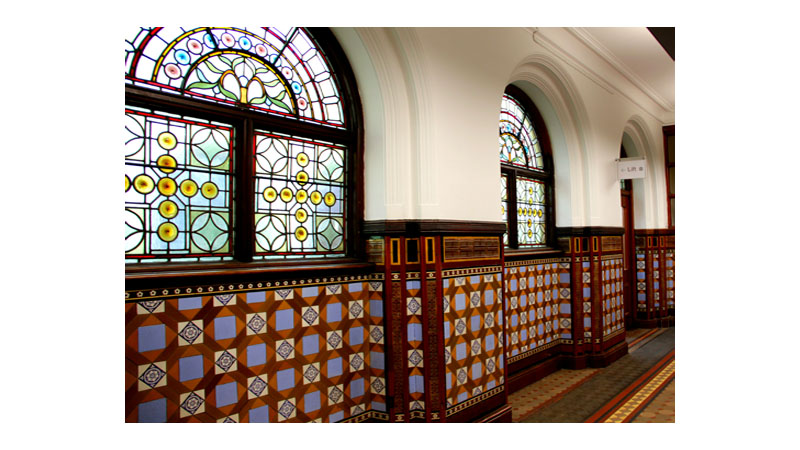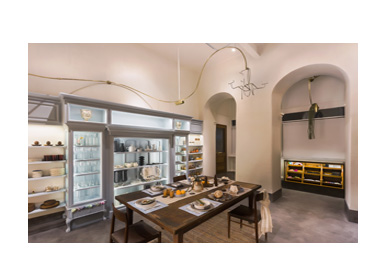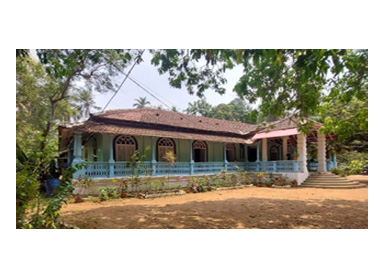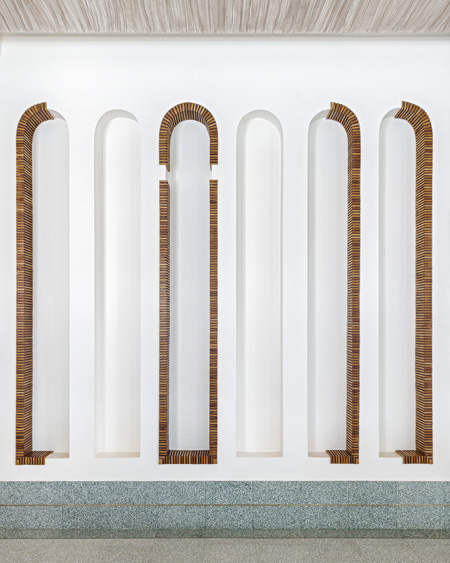100 Years
100 Stories


Leeds Central Library, Courtesy Wikimedia Commons
Have you noticed a curious element on staircases sometimes? The lower half of the wall along the staircase, upto about 3 to 4 feet from the floor, is lined with a material separate from the rest of the wall. You’ll also find it on the base of pillars and occasionally even on the walls of corridors. A key visual element to a space, modern or period, the dado or “die” ( the architectural terminology for the middle section of a pedestal or plinth) serves both a functional and aesthetic purpose.
A dado did not just make a visual statement, it served a definite function. During the Georgian period in England, it was customary to leave dining chairs drawn up to the walls, away from the table, and the dado was introduced to protect the lower part of the wall from the marks of stairs pushed against the wall and from stains caused by rising damp or grimy hands. Commonly used in the reception room, the hallways and on staircases, the dado was usually found in the houses of the wealthy or in public buildings. In the Indian context, the climax of the dado as an architectural ornamentation can be traced to the Mughal period, when it was used to demonstrate their refined artistic sense in the form of beautiful designs. Mural or dado decoration was typically applied on the walls of the buildings like palaces or mosques. It included tile decoration, mosaic painting, stucco, inlays and carvings in marble in high and low relief.
The arrival of Art Deco in India in the 1920s and 1930s triggered a flurry of changes in architectural styles, most notably the re-emergence of the dado as a key architectural element. Dado now an established part of interior design, were used in bathrooms, kitchens, porches, and other tiled areas of the home. Bharat Floorings and Tiles completed several schemes in various buildings, including dado work, that were notable for their distinction and marked variety. Bharat's portfolio has always included dado work, with marble, granite, terrazzo, and tiles used to embellish walls in unique ways. Rich in colour and smart in design, as well as impervious to dirt and liquids, dado work done by Bharat 90 years ago is still preserved in stately buildings and residential houses in Mumbai. Old dados have been lovingly restored and new dados and wall claddings have expressed contemporary creativity.
A few of the most prominent examples would be Dhanraj Mahal and Kamal Mahal in Mumbai, where Bharat carried out the tiling and dado work when they were built in the 1930s. In the imposing Reserve Bank of India the bathrooms and the floors had dados in marble mosaic. The busy Bombay Central Terminus was graced with high-quality Italian marble chips in its dado work and in the Bombay Mutual Life Assurance the 8 feet high dado work in lobbies and staircases was done in Polceivero dark green.
Bharat’s iconic dado work can also be seen in Mafatlal Park where BFT had executed 8000 sq ft of dado work in black marble strips. The Times of India also couldn't resist featuring the light blue tiles installed by Bharat at the Aarey Milk Colony! It was "unique" and indeed "a departure from the usual Dado work carried out in most buildings", they wrote. Interestingly, Bharat did dados in many of Mumbai’s iconic cotton textile mills to enable easy cleaning of the cotton fluff from the walls.
Constantly invented and reinvented as per trends, there is no surprise that the dado is now back and coming “into fashion” again! It is making a mark in styling by enhancing hallways or lending character to a space. And the dado has made its way into new spaces as well! In what would otherwise be blank spaces, Bharat’s clever use of eye-catching Dado Tiles on bar or kitchen counters has added new visual elements. Examples of this can be seen in Malaka Spice in Hyderabad, The Pantry in Kala Ghoda, Mumbai, or the De Pizza Mania in Andheri, where simple dado panelling in tiles has made a statement. The green terrazzo dado work that can be seen in the Goan Vaddo home designed by Studio Flamingo illustrates a timeless character, creating a sense of serenity, yet bringing a quirky edge to the spaces.
What's more the brand has developed a host of new materials and designs that can be used in dado work. Bharat's stylish 3D textured wall claddings and the Soft Brutalism range demonstrate a creative use of wall tiles that can be used on counters and walls alike. Economical and yet ingeniously designed in a way to catch light at various angles, this range of wall claddings is the product in demand for hotels, pubs and restaurants. BFT’s Hills and Valleys 3D wall cladding can be found on the kitchen counter of Neel All Day restaurant in Mumbai designed by Studio Osmosis, at the Koko Asian Gastropub where the 80 Hexar 3D Wall Cladding highlights and harmonises with the ambience of the pub, and at the Fez, in New Delhi where the wall claddings reflect the overall chic vibe of the pub.
Although its popularity has had its ups and downs, dados are now back with a bang! Contemporary in their design, dados now come in all kinds of styles and for all types of functions. A period feature with enduring quality, this timeless trend adds tons of character and makes a luxurious and personalised statement in every space it's used in.
You may also like
-
 61MicrocementThinking about getting a microcement floor? Read this piece. If not, read it to know why you should get one.Read More
61MicrocementThinking about getting a microcement floor? Read this piece. If not, read it to know why you should get one.Read More -
 62BFT+A daring leap of faith by Firdaus gave Bharat its first designer tiles. This is the story of the BFT+ tile range.Read More
62BFT+A daring leap of faith by Firdaus gave Bharat its first designer tiles. This is the story of the BFT+ tile range.Read More -
 63My Home Alinto CoelhoStep into the timeless charm of an Old Goan house, where Bharat tiles hold the memories of generations. Discover the rich history of these iconic tiles and how they've become an integral part of this heritage home's story, all with a touch of nostalgiaRead More
63My Home Alinto CoelhoStep into the timeless charm of an Old Goan house, where Bharat tiles hold the memories of generations. Discover the rich history of these iconic tiles and how they've become an integral part of this heritage home's story, all with a touch of nostalgiaRead More





